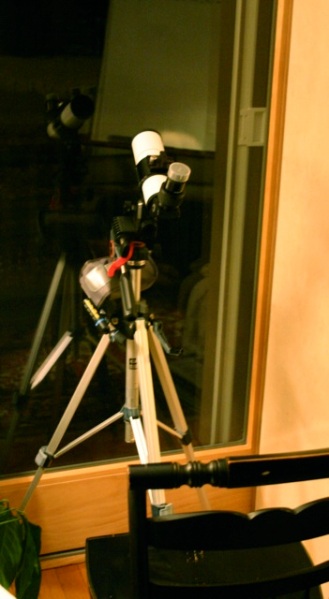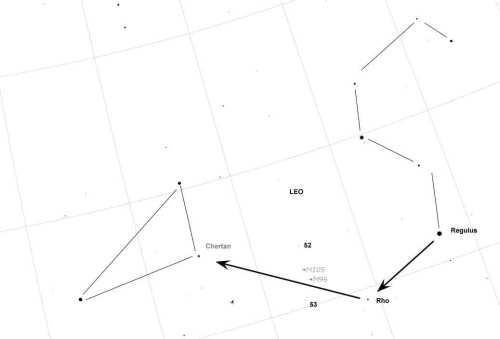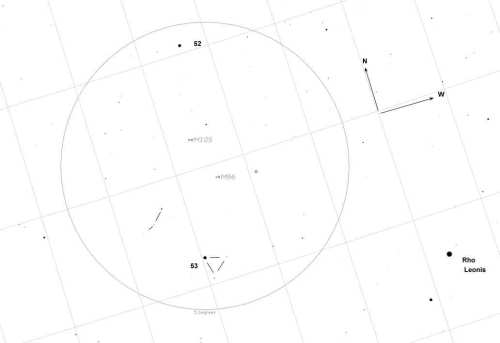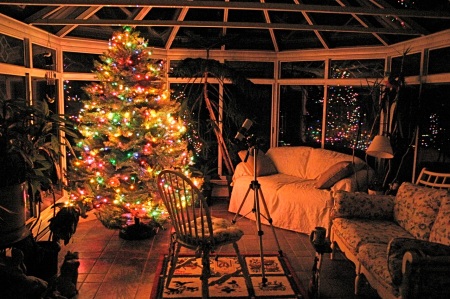How do I test thee, little 10-inch Dob, let me count the ways!
Let’s take Em Three, Castor’s six, and one Iota of Cas-sio-peia;
Mix with Polaris and pal, plus Em Eighty One with Eighty Two;
Em Fifty One, the Siamese pair, then Saturn and Mars too;
Now Leo’s Triplet, you know – Em Sixty-six and Sixty-five,
and ghostly En Gee See Three Six Two Eight – whew!
I know, I know, no rhyme, but there’s reason – no rhythm, oh poo
What’s left?
A hive of bees, a Cobra too,
Still more?
Well yes, two unknowns
swept up in a trice,
not a bad deal,
– well worth the price!
With tons of apologies to Elizabeth Barrett Browning and all other real poets, living or dead! – I know it’s not poetry, but I couldn’t think of another way to express the enthusiasm of the moment 😉
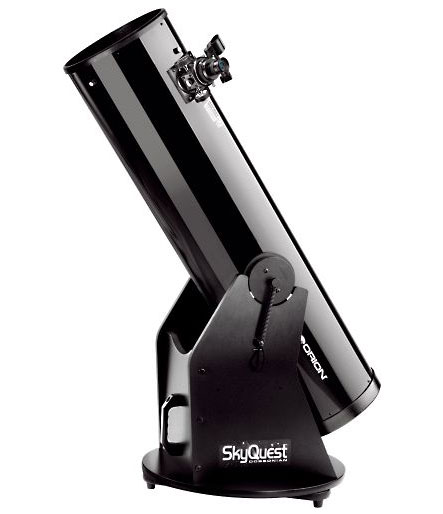
Yes, I’m talking about an Orion XT10 Dob that I bought slightly used for $500 several months ago and yes it has a little computer – digital setting circles really – and no, I didn’t use the cpomputer. Actually, I would have preferred a “classic” without the computer, but at least I can leave the lectronics in the house and I’m always thinking of resale value and I assume most people prefer the computerized version. And while the above just doesn’t make poetry, it did make for a great celestial tour, completed in a bit under two hours – the temperature was 23 degrees and there was a wind – and I did linger on several objects and managed to see four early Geminids as well! That’s my kind of observing. Did I mention this was at 4 am and I had had a good, solid, 3.5 hours sleep, so my spirits were up?
But really – my goal this morning was to assess the 10-inch Dob for optical performance, ease of use, and comfort. It scored high in all three categories. See, I had taken the 15-inch down today because I plan to send the mirrors off for resurfacing. So the 10-inch Dob is a stand-in. Given its performance and comfort level when using – critical to me, not so critical to others – the 15-inch could be out of a job. I’m getting too old for high seats – almost fell off the other night – a tad scary.
But can I really find happiness with a dinky little 10-inch Orion? Ask me in a couple months. I tend to fall in love easily. This relationship might not hold up amid new challenges and bad moods – I can go downhill fast when sleep deprived. Still, I was very impressed. Here are the details.
First, comfort. This isn’t trivial. I don’t think you can do serious observing if you are stressed – and thus distracted – while sitting at the eyepiece.I have one of those thickly padded, piano-stool-like observing chairs that has seen little use because, while height adjustable, it doesn’t have much reach. It’s perfect for the 10-inch Dob though. The objects I looked at ranged from a low of about 30 degrees (Iota Cassiopeia), to a high of around 62 degrees and I only adjusted the chair once. Were I looking at the zenith it still would require only a slight adjustment. So that means little fiddling witht he chair and its comfortable – not as comfortable as my office chair in the observatory, but a big change over trying to get cozy with the 15-inch.
Perhaps more important was I found it easier to find a comfortable – and secure – position on this seat without going through excessive contortion to look through the eyepiece. Still, this is the Dobs weakest point in my mind. My arrangement now with the Stellarvue SV80ST Lomo in the Observatory is ideal. I use a comfortable office chair and a rugged Universal Astronomics T-Mount to bring the eyepiece to me in a position that requires no contortions and results in completely comfortable observing. So while the 10-inch scores higher than the 15-inch in this respect, it scores lower than an ideally -mounted, small refractor. I’d give it maybe a B- in this category. I wasn’t uncomfortable, but I don’t know how it would stand up under a serious observing session where I try to draw what I see.
There’s something else going on here that’s true of any Dob/Newtonian – your looking in the side of the telescope. I really prefer to be seated behind a telescope so that when I look up from the eyepiece I see my target with the naked eye. This is one of those very subjective things that bothers me, but may be of zero concernt o another observer.
OK – second test category – ease of use. Does it move smoothly and quiet down quickly. Yes. It’s no Obsession. The “buttery” feel isn’t there. But it moves with reasonable ease both for finding and tracking. The azimuth motion is a bit more problematic than the altitude motion. This is a very practical concern and the inexpensive Dob does well, though isn’t perfect.
What about finding things – manually? No Dob is intuitive. Sitting behind a refractor and pointing it is as instinctive as pointing your finger., Sitting beside a Dob and pointing it is not. The 10-inch is no exception. What is good, however, is you can position both a unit finder and optical finder on it and I have done so. The unit finder is a Rigel with a pair of red bulls eyes to aim at your target and once you get used to where to position your head in order to see through it, it’s clear sailing. That puts you in the right region. The 8×30 correct view, right angle optical finder then helps you zero in on your target. I found this all very doable and in quick time – BUT I frequently felt the need to get off the stool and put a knee on the ground in order to see through the Rigel finder. That’s a minus, though not a big one. (Normally I wouldn’t be changing targets this frequently, for one thing.)
I like the handy eyepiece rack and changing eyepiece wasn’t a hassle. Focus is hardly like the dual-speed Feathertouch on the the 15-inch and SV80St – it’s a single speed and rather clunky – but I never had any serious problem achieving precise focus. A better focuser would be a luxury on this scope – not a necessity.
So ease of use? The mark moves up to a B.
Now – optical performance. Here I found myself mumbling things like “Oh man! Wow!” and “This is scary good!”
I mean it. Maybe the mirror on the 15 has really degraded over five years of exposure to an unfriendly environment. Maybe my memory of the views in it are just foggy. And maybe a 15-inch simply isn’t that big of a jump – about twice the light gathering power – over a 10-inch. In any event, the 10-inch blew my socks off on all deep sky objects, did a creditable job on double stars, and wasn’t bad at all on the planets.
I started with the most delightful sight – in my humble opinion – that a large reflector has to offer, a bright globular cluster. In this case, M3 was handy, though only about 40 degrees high in the east. It took only a glance with the 24mm Panoptic eyepiece to be convinced that good things were ahead. When I zoomed in tight with a 5mm (240X) eyepiece I was greeted by a wonderful snowball, studded with ice crystals – in other words, many of the stars resolved beautifully. At that power it does drift through even a Nagler eyepiece fairly quickly – but not so quickly to make observing difficult and this was one of the tests of how easy the scope was to move and track without disturbing the view for extended periods of time.
OK – how it do on a double? This is an area where I have found the 15 frustrating and I think its simply because the large objective means that it is more easily impacted by poor seeing conditions. So the bottom line is this – when I looked at the familiar triple star Castor, I found the view better than what I remember seeing with the 15 inch and not as good as what the 80mm Stellarvue delivers. The reason? I would attribute almost all of the difference to how the larger scopes are more easily impacted by poor seeing. Seeing was ok – but hardly ideal. I didn’t do a side-by-side test, so this will have to stand as an approximation – first impressions.
I wondered how it would do on a fainter multiple star, so I turned to what is a real challenge for an 80mm, Iota Cassiopeia. Great! I find the view of this in the 80 mm charming – and it was the last thing I had looked at with that scope about 6 hours before. But I wouldn’t try to show that to a visitor. Seeing this triple with the 80mm requires very precise focus and a good idea of what you expect to see. In other words, its a fine target for an experienced observer. If I wanted to show off Iota Cassiopeia to visitors, i would definitely use the 10 inch. A little sloppy, but when seeing settled down, just beautiful – and the split was wide enough so I have no doubt even a casual visitor would see it and be impressed.
I found a quick peak at Polaris very impressive as well – very easy split. So I decided to go after M81 and M82 – never easy to locate, but using both finders I found them in a minute or two. That was a wow! Not the finding, but the seeing. M81 certainly looked like the impressive spiral it is, and in M82 the dark cloud that cuts diagonally across this cigar-shaped galaxy was immediately obvious. With both I felt I could spend a lot of time attempting to draw what I could see. I went to M51, the Whirlpool, and had the same impression. I’m sure they were all better in the 15-inch – just not enough better to make a big difference to me. At this stage I’d rather use the 10-inch for how much it delivers in relative comfort.
On my way to the Leo Triplet I dropped by Saturn long enough to be impressed. I could see three or four moons, but I didn’t dally here. Planets are not that important to me and I’m no real judge of a scope’s performance on them, though I will say the best views I’ve ever had of the elusive Mars is with a 100mm refractor. Nothing I saw of either Saturn or Mars this morning made my think the 10-inch could do better unless seeing conditions were really exceptional.
The Leo Triplet? it just popped. Not only M65 and M66 – I expect them to be easy – but NGC3628 is usually a minor challenge and it wasn’t one at all this morning. Transparency was awfully good, of course, but the 10-inch took full advantage of it, delivering all three galaxies easily.
By this time there were some hints of dawn, but to round things out I took a quick look at two open cluster, M44 and M67, spending more of my time on M67. I’ve examined both recently with the 80mm refractor and the 10-inch did a more impressive job – it should, especially with M67 which has lots of faint background stars. But my overall impression was very positive.
Oh – and the unknowns? The one near M81 I’m 95% sure was NGC2976 with an apparent magnitude of 10.8 – about three magnitudes fainter than M81 – that fits my impression. The other, I just don’t have a clue. Didn’t have time to sketch the field as I did with NGC2976.
So, for the optical scorecard, a B+ or maybe A-. The only real issue is the unavoidable one of performance being impacted by seeing and that’s simply an issue of size as said – comes with the territory. For what it is meant to deliver – the faint fuzzies – it did exceptionally well.
So now the question is simple. Will first impressions last? Or will this just be a case of puppy love. I don’t entirely trust my enthusiasm and, of course, I know that I had very good transparency which is just what this scope needs to bring out its best points. So, let’s see where I am after a few months. If I could figure a way to get comfortable using the 15-inch there would be no question. But as I get older I get less impressed with sheer size and more impressed with what a telescope can deliver without demanding too much of me in terms of bodily contortions – in a word, stress.
And is this the ideal large telescope for my situation? I’m not at all sure. In the back of my mind I’m thinking of a 10-inch or 12-inch Meade LX200 Schmidt-Casegrain. They’re compacta nd you sit behind them las with a refractor. The Meade’s – unlike the Celestrons I’ve met – have manual slow motion controls and thus can be used manually. Maybe I can find one on the used market where the motors and computers are burned out and the owner wants to unload it cheap – stay tuned 😉
Read Full Post »
